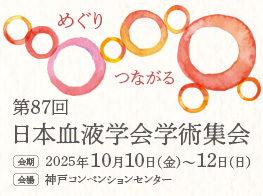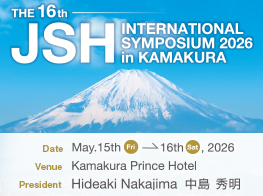名前:関 正史【東京大学医学部附属病院小児科】
発表日時:2017年6月25日
発表形式:Oral
Title:
Identifications of novel recurrent pu.1 fusions with highly aggressive phenotype in pediatric t cell acute lymphoblastic leukemia
Authors:
Masafumi Seki1 , Shunsuke Kimura2, Tomoya Isobe1, Kenichi Yoshida3, Hiroo Ueno3, Hiromichi Suzuki3, Yusuke Shiozawa1, Keisuke Kataoka3, Yoichi Fujii3, Yuichi Shiraishi4, Kenichi Chiba4, Hiroko Tanaka4, Teppei Shimamura5, Lin Lin6, Masatoshi Takagi6, Changshan Wang7, Atsushi Iwama7, Kentaro Ohki8, Motohiro Kato8, Yuki Arakawa9, Katsuyoshi Koh9, Ryoji Hanada9, Hiroshi Moritake10, Masaharu Akiyama11, Ryoji Kobayashi12, Takao Deguchi13, Yoshiko Hashii14, Toshihiko Imamura15, Atsushi Sato16, Nobutaka Kiyokawa8, Akira Oka1, Yasuhide Hayashi17, Atsushi Manabe18, Akira Ohara19, Keizo Horibe20, Masashi Sanada20, Hiroyuki Mano21, Satoru Miyano4, Seishi Ogawa3, Junko Takita1
Affiliations:
1 Department of Pediatrics, The University of Tokyo Hospital, Tokyo
2 Department of Pediatrics, Hiroshima University, Hiroshima
3 Department of Pathology and Tumor Biology, Graduate School of Medicine, Kyoto University, Kyoto
4 Laboratory of DNA Information Analysis, Human Genome Center, Institute of Medical Science, The University of Tokyo
5 Division of Systems Biology, Nagoya University Graduate School of Medicine, Nagoya
6 Department of Pediatrics and Developmental Biology, Tokyo Medical and Dental University, Tokyo
7 Department of Cellular and Molecular Medicine, Graduate School of Medicine, Chiba University, Chiba
8 Department of Pediatric Hematology and Oncology Research, National Research Institute for Child Health and Development, Tokyo
9 Department of Hematology/Oncology, Saitama Children's Medical Center, Saitama
10 Division of Pediatrics, Faculty of Medicine, University of Miyazaki, Miyazaki
11 Department of Pediatrics, The Jikei University School of Medicine, Tokyo
12 Department of Pediatrics, Sapporo Hokuyu Hospital, Sapporo
13 Department of Pediatrics, Mie University Graduate School of Medicine, Tsu
14 Department of Pediatrics, Osaka University Graduate School of Medicine, Suita
15 Department of Pediatrics, Kyoto Prefectural University of Medicine, Graduate School of Medical Science, Kyoto
16 Department of Hematology and Oncology, Miyagi Children's Hospital, Sendai
17 Gunma Children's Medical Center, Shibukawa
18 Department of Pediatrics, St. Luke’s International Hospital
19 Department of Pediatrics, Toho University, Tokyo
20 Clinical Research Center, National Hospital Organization Nagoya Medical Center, Nagoya
21 Department of Cellular Signaling, Graduate School of Medicine, The University of Tokyo
Abstract:
Background: T-cell acute lymphoblastic leukemia/lymphoma (T-ALL/LBL) accounts for 10% to 15% of newly diagnosed cases of childhood acute lymphoblastic leukemia (ALL), arising from the malignant transformation of hematopoietic progenitors primed toward T cell development, as result of a multistep oncogenic process. However, since the prognostic significance of these genetic alterations in pediatric T-ALL is not clear, genetic basis which contributes aggressive phenotype or progression of pediatric T-ALL is still to be elucidated.
Aims: To discover driver genetic events, which involved in the aggressive phenotype of pediatric T-ALL and to identify its novel prognostic markers, we performed integrated genetic analysis in a large cohort of T-ALL case.
Methods: Our cohorts included samples from Tokyo Children’s Cancer Study Group (TCCSG) and Japan Association of Childhood Leukemia Study (JACLS). Whole transcriptome sequencing (WTS) was performed in 123 cases. Whole transcriptome sequencing (WTS) was performed in 123 cases.
Results: Representative recurrent fusion genes were as follows, SIL-TAL1 (n=25), MLL-ENL (n=5), PICALM-MLLT10 (n=5), and NUP214-ABL1 (n=2). Intriguingly, novel recurrent in-frame PU.1 fusions (STMN1-PU.1 n=2; TCF7-PU.1 n=5) were detected, and RT-PCR analysis in additional 60 cases revealed other 2 TCF7-PU.1 fusions. Thus, PU.1 fusions accounted for 4% of pediatric TALL/LBL. Expression data of WTS revealed cases with PU.1 fusion showed significantly higher expression of PU.1 compared to cases without PU.1 fusion, implicating that aberrant high expression of PU.1 involved in leukemogenesis. Using consecutive two-step unsupervised consensus clustering, we obtained 5 stable clusters. Among these, 4 clusters largely recapitulated distinct T-ALL subtypes characterized in previous studies by an early T-cell precursor (ETP) signature (ETP-ALL), 2 clusters of high TAL1 expression (TAL1-RA and -RB -ALL), and mutually exclusive expression of, TLX1, and TLX3 (TLX-related-ALL). However, the remaining one was newly identified and exclusively consisted of the 7 PU.1 fusion-positive cases. Compared to ETP-ALL, these PU.1 fusion cases typically showed a reduced expression of the phase I genes implicated in early T-cell development, except for PU.1, which was ectopically up-regulated by the relevant gene fusions. All cases with PU.1 fusion were grouped into PU.1 high cluster. Moreover, PU.1 high cluster had distinct genetic features with mutations of transcription factors, such as GATA3, RUNX1, and EVT6. Of note, significant poor outcome was confirmed by multivariate analysis in cases with PU.1 high cluster (p = 0.048). Consistently, we defined PU.1 overexpression cases as outliers of PU.1 expression, which resulting in extremely poor prognosis (3-year OS 21%, log-rank p = 6.9 ×10-7).
Summary/Conclusion: PU.1 fusions expressing cells expanded and they remained at an immature stage, implicating a potential leukemogenic activity of these fusions. Not only the cases with PU.1 fusions, but also the cases with high PU.1 expression without fusions showed extremely poor prognosis, suggesting the prognostic value of aberrant PU.1 expression in pediatric T-ALL. Although it remains unclear, why cases with PU.1 fusions/high PU.1 expression have a poor prognosis, our results indicate that these cases are genetically distinct subgroup from other pediatric T-ALL.
EHA2017参加レポート
この度は22nd Congress of European Hematology Association (EHA)での発表にあたり、日本血液学会EHA travel awardの受賞を賜り、誠に光栄に存じます。今回のEHAはスペインのマドリードで2017年6月22日から25日まで開催されました。学会会場は市街地から電車で30分程かかる郊外にありましたが、比較的地下鉄などからのアクセスはしやすく、空港のそばにあることから初日や最終日も時間的に有効に学会に参加できる環境でした。この時期のマドリードは夜10時頃でも明るいため、食事や観光など充実した時間を過ごすことができました。
私は今回小児T細胞性急性リンパ性白血病 (T-ALL)における新規SPI1融合遺伝子の同定に関して、結果を報告いたしました。小児T-ALLは、小児がんで最も頻度の高いALLのうち15%程度を占める疾患ですが、再発や治療抵抗性の症例は極めて予後が不良なことが知られていましたが、一方でその原因となる分子以上に関しては十分に知られていませんでした。本研究ではRNAシーケンス解析を中心とした解析を行い、小児T-ALLの約4%に新規SPI1融合遺伝子を同定しました。また、SPI1融合遺伝子症例は極めて予後が不良であり、新規の予後不良因子であることが示され、今後、治療の層別化や新規治療法の導入などに、臨床的にも重要な知見として応用されていくことが期待されます。
EHAは今回始めて参加いたしましたが、ASHに比べ規模はコンパクトでありながら、これまでの知見をまとめた教育講演や最新の研究結果まで幅広く網羅されており、どのセッションを聞くか悩む時間も多くありました。教育講演に関しては2回行われるものもあり、また期間は限定されますがweb上でスライドやプレゼンテーションを見直すことができる演題もあります。また、ポスター発表も活発に討論がなされており、EHAの委員の方なのか、プレゼンテーションを発表者に求め、その評価も行い、発表者にフィードバックしている様子もあり、学会全体として若手医師への教育に重点をおいているという印象を受けました。
私のテーマであるT-ALLに関する演題や、小児を対象とした演題もいくつかあり、多くの刺激を受けることができました。新規治療として、小児T-ALLのRPL10変異例におけるBCL2阻害剤の効果を示した報告や、台湾からの小児T-ALLにおけるゲノムの全体像に関する報告、MYB過剰発現によるT-ALLのマウスモデルなど、臨床・基礎いずれも興味深いものが復数あり、改めてT-ALLに対して多くの人が研究していることを実感しました。
最後に、今回このような機会を与えてくださった日本血液学会事務局、国際委員の先生方、日々研究のご指導を頂いております滝田順子先生、京都大学の小川誠司先生、また検体提供にご同意いただいた患児のみなさまとそのご家族に深謝申し上げます。



